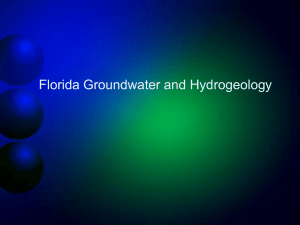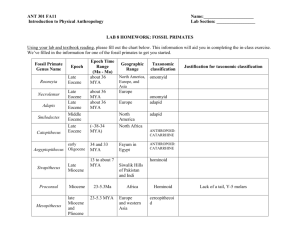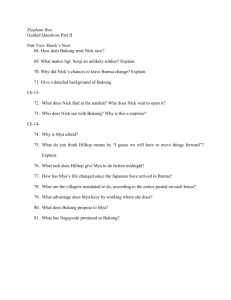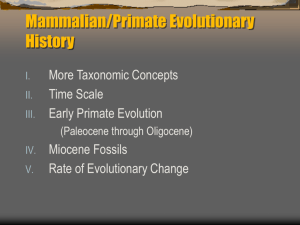Florida Geology ppt.
advertisement
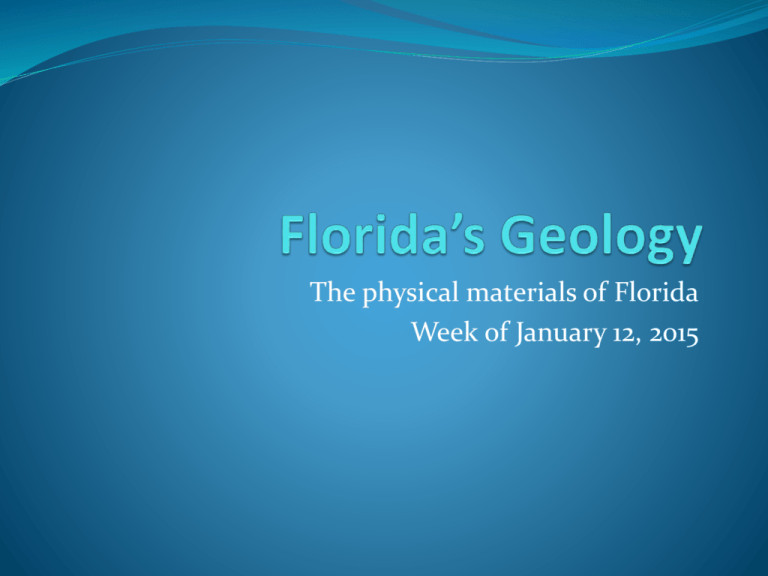
The physical materials of Florida Week of January 12, 2015 Geology = Geo- , Latin for earth. = Why study it for Florida Ecology? Geologic Time •Florida Broke to the surface as land 35 to 25 million years ago (mya) •The bedrock of Florida accumulated for millions of years Building a Foundation Pangea = a supercontinent (~550mya) and the separation of the continents through continental drift. Florida’s limestone bedrock was attached to Africa, in a rift, then pulled apart with the North American continent. Evidence for Pangea Same rocks and sediments and fossil deposits containing same species discovered on separate continents--separated by Atlantic Ocean Continents appear to “fit together like puzzle pieces” How did Pangea break apart? Theory of Continental Drift, 1950’s and 60’s. Earth crust made up of many “plates” The boundaries where ocean plates meet are mid-ocean ridges. New sea floor created here. Other plate boundaries responsible for volcanoes, earthquakes, mountain building Evidence for Continental Drift Young sea floor (at a ridge) had little time to accumulate sediments Rocks are older and sediment is thicker as you move away from the ridge The rocks of the sea floor show the earth’s magnetism at the time of their cooling = magnetic anomalies. Florida as Africa Florida’s limestone bedrock was attached to Africa, in a rift, then pulled apart with the North American continent. Florida's Movement Major Eras in the Natural History of Earth 1) Paleozoic: 550-250 mya Early Animal Life in the Oceans Fishes Diversify Ferns and Early plants begin to colonize land 2) Meozoic: (250 to 65 mya) Reptiles Diversify, Age of Dinosaurs Gymnosperm Plants = most softwoods with seeds in cones diversify 3) Cenozoic :(65 mya to Present) Mammals diversify Flowering plants =Angiosperms, Harwoods Diversify Florida Emerges as a LANDMASS Cenozoic Era: 65 mya to Present Tertiary Period Paleocene 65-53 mya Eocene 53-34 mya Oligocene 34-23 mya (Florida Emerges at end here) Miocene 23-5 mya Pliocene 5-2 mya Quarternary Period Pleistocene Epoch 2mya to 10,000 years ago Holocene (Recent) 10,000 years ago to present Florida as a Landmass Earlier shorelines determined by looking at fossils in marine deposits Florida has changed size in the past 35 million years High sea level/Interglacial warmer climate = island chains Low sea level/Ice ages = twice the present landmass Panhandle emerged ~25 mya Last time peninsula underwater 23 mya Florida Platform -limestone dominated flat topped structure 3 components of Platform 1) Basement rock-Paleozoic & some Mesozoic 2) Carbonate rock- Mesozoic & Cenozoic era 3) Siliciclastic sediments (mostly quartz sand)Cenozoic era 1) and partially 2) when still part of Gondwana (Africa) Paleocene and Miocene 65-34 mya Paleocene and Miocene 65-34 mya Many fossils from this time period are found: Sea grass fossils - Oligocene 34-23 mya Late Oligocene 25-23 mya FL many islands before complete emergence Late Oligocene: Sea level fell ~ 300 ft. Florida Emerges ~ 24 mya. Gulf Trough a narrow inlet or estuary, but filling in Fossils from this time period: Oligocene 34-23 mya Insects, bats, birds, tortoise Land Mammals (Beaver, deer, rodent, rabbit, anteater, goat, horse, pig) like creatures Opposum Saber-toothed cats Oligocene 34-23 mya Read and record about Oligocene Miocene 23-5 mya Gulf Trough filled in Parts of FL repeatedly submerged and exposed Freshwater communities emerging Diverse Animals: Miocene 23-5 mya Read and record about Miocene Pliocene 5-2mya Inter-glacial Period, Warm Climate High Sea Level North American continent is dry FL has enough water resources to support Mammal Diversity on semi-arid savannahs and subtropical forests Pliocene Megafauna Horse Camelid Glyptodont Sloth Mammoth Mastodon Giraffoid Rhinoceroid Long nosed Peccaries Megalonyx jeffersoni Giant ground sloths 8-10 feet, up to 800 lbs Vegetarian, Foraged on trees. Mammuthus- Wooly Mammoth Mammut- American Mastodon Pleistocene 2mya to 10,000 ybp Many of these same animals went extinct in the late Pleistocene. Another ice age occurred, Colder climate Low sea level A landbridge between N and S. America forms allowing for long isolated species to travel North and South. The Great American Biotic Interchange The Great American Biotic Interchange …During Late Pliocene/Early Pleistocene… From South America From North America Opossum Raccoon Armadillo Llama Flying Squirrel Coral Snakes Vampire Bats Many Pit Vipers Lots of Frogs Jaguar Hummingbirds Formation of the Gulf Stream Remember: Ice Age, Low Sea Level, Central America Appearing…. Blocked Pacific from the Atlantic Diverted Ocean Currents Gulf Stream created! Altered Climate Warm air and water moving to poles, cooled to make precipitation, creating much more snow and ice. Ice caps grew and repeated Ice Ages. Coral Reef Formation around Florida Gulf Stream also took away nutrients from the warm waters, making ideal conditions for coral reefs to become established. Evolution of Staghorn and Elkhorn Coral Species Pleistocene continues The Bering land bridge was also exposed during these global ice ages, allowing Asian species to migrate to North America. Long-horned Bison Holocene Period ~20,000 years ago to Present Periods of warming and cooling continue on a smaller scale Humans arrive to N. America via Bering Land Bridge Most mammal megafauna extinct, due to: Southeastern U.S Coastal Plain Florida a part of this region. Area of sediments that spreads from the southern Appalachian Mtns. Piedmont to the coasts Piedmont = a rocky skirt that surrounds mountains Florida: 3 layers of sediments Sediments = loose materials deposited on the land or at the bottoms of water bodies 1) Fragments of rocks from land 2) Materials formed beneath the sea 3) Organic matter Florida’s Bedrock Bottom layer: Marine sediments Build-up of ancient marine sediments Originate from salts, dead organisms with shells that settle out of ocean waters Florida’s major ones: Limestone & Dolomite Calcium carbonate and Magnesium carbonates Middle Layer: Clastic Sediments Loose Clastic sediments Fragments of rock Mostly Quartz (Silicon Dioxide SiO2) and Feldspar (Aluminum Silicates AlSi#O#) From erosion of Appalachian Mtns. In form of clay, silt, sand, gravel Top layer: Soil=particulate material lying a lop land, which is capable of supporting plant life. Mixture of Marine and Clastic Sediments with Organic Materials Vary in Size of sediments Vary in pH from Acidic to Alkaline Vary in ability to retain water Xeric 300 types of soils in Florida contribute to the diversity of our ecosystems. Mesic Hydric Soil Types Xeric Dry Soils Rain water drains rapidly Contains ample oxygen to meet plants needs Mesic Moist soils that do not become waterlogged Drain well and hold oxygen Hydric Wet soils, may becomes waterlogged Low oxygen concentrations
